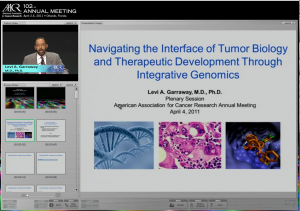MEK mutations confer resistance to MEK and BRAF inhibitors in melanoma
The other day, we discussed resistance in melanoma and how COT can reactivate BRAF signalling through MAPK reactivation. Previously, we reviewed how MEK inhibitors may potentially be useful when combined with BRAF inhibitors in overcoming resistance due to cross-talk. There are also other methods of preserving this oncogenic activity, which are highly relevant to current clinical development.
At the recent American Association for Cancer Research (AACR) meeting, Levi Garraway (Dana Farber) presented at the plenary session on “Navigating the interface of tumor biology and therapeutic development through integrative genomics.” He first discussed the history and context of targeted therapy, then focused on the progress in metastatic melanoma, highlighting some dramatic responses to the BRAF inhibitor PLX4032 (vemurafenib) using before and after pictures of his patients.

The talk was very well done indeed and I was so engrossed in following the story, I forgot to make notes – that’s how good it was! The good news is that AACR captured the excellent slides and audio in a free webcast. If you have 20 minutes, please do take some time to check this one out – it was one of my highlights of the meeting.
Dr Garraway also drew the audience’s attention to a poster from Wagle et al., (2011) based on new research from his lab looking at a new mechanism of resistance in melanoma, namely mutations in MEK. Unfortunately, I missed the poster that morning, but the group kindly referred me to their publication in Journal of Clinical Oncology last month (see references below), which offers more detail for discussion here.
Essentially, they used a genomics approach to see if they could advance our understanding of mechanisms of de novo and acquired resistance to RAF inhibition, which are poorly understood. To put things in context, the same patient that Dr Garraway refers to in the webcast above was also the subject of the genomics profiling in the paper:
“We performed massively parallel sequencing of 138 cancer genes in a tumor specimen from a melanoma patient who developed resistance to PLX4032 after a dramatic initial response.”
Initially, the patient responded to therapy:
“A profound clinical response ensued, including nearcomplete regression of all subcutaneous tumor nodules at 15 weeks on drug.”
The pictures of the patients torso in the webcast were dramatic. There were several involuntary sharp intakes of breaths from the audience around me in the session.
Unfortunately, it wasn’t all good news:
“After 16 weeks on PLX4032, the patient experienced widespread disease relapse, which by 23 weeks involved most previous sites of visceral and subcutaneous disease.”
The pictures in the webcast also showed the physical impact of this sad news. The key question then, is why did the patient relapse?
The genomic profiling undertaken by the group addressed this question and uncovered something unexpected:
“The resulting profile identified a novel mutation in the downstream kinase MEK1 that was absent in the corresponding pre-treatment tumor.
This MEK1 mutation was shown to increase kinase activity and confer robust resistance to both RAF and MEK inhibition in vitro.”
What are the implications of this research?
This was a very nice piece of work that sought to uncover the reason for a responding patient becoming resistant to treatment with PLX4032. The researchers found a downstream MEK1 mutation was responsible for inducing resistance.
The implications of the finding, however, are slightly scary.
Why? Because as the authors concluded in their paper, the MEK1 mutation found in this patients is cross-resistant to allosteric MEK inhibitors (eg AZD6244), even though the patient has never been exposed to a MEK inhibitor. It also implies a mechanism by which melanoma may become resistant to combination RAF and MEK inhibitors (eg PLX4032 + AZD6244) with just a single mutation.
In other words, we still have a ways to go figuring out all the potential combinations and methods of resistance that could take place in this disease. The good news is that research into mechanisms of resistance is running parallel with clinical development in metastatic melanoma and will hopefully continue to do so.
References:
![]() Wagle, N., Emery, C., Berger, M., Davis, M., Sawyer, A., Pochanard, P., Kehoe, S., Johannessen, C., MacConaill, L., Hahn, W., Meyerson, M., & Garraway, L. (2011). Dissecting Therapeutic Resistance to RAF Inhibition in Melanoma by Tumor Genomic Profiling Journal of Clinical Oncology DOI: 10.1200/JCO.2010.33.2312
Wagle, N., Emery, C., Berger, M., Davis, M., Sawyer, A., Pochanard, P., Kehoe, S., Johannessen, C., MacConaill, L., Hahn, W., Meyerson, M., & Garraway, L. (2011). Dissecting Therapeutic Resistance to RAF Inhibition in Melanoma by Tumor Genomic Profiling Journal of Clinical Oncology DOI: 10.1200/JCO.2010.33.2312